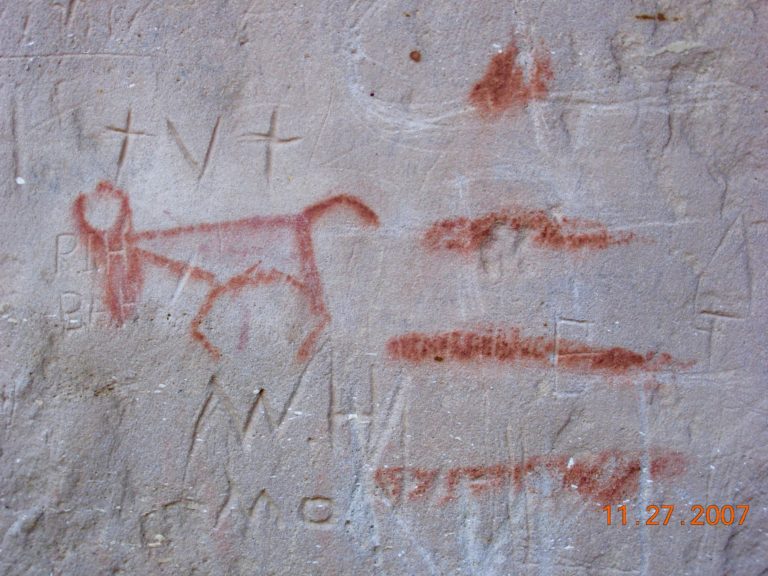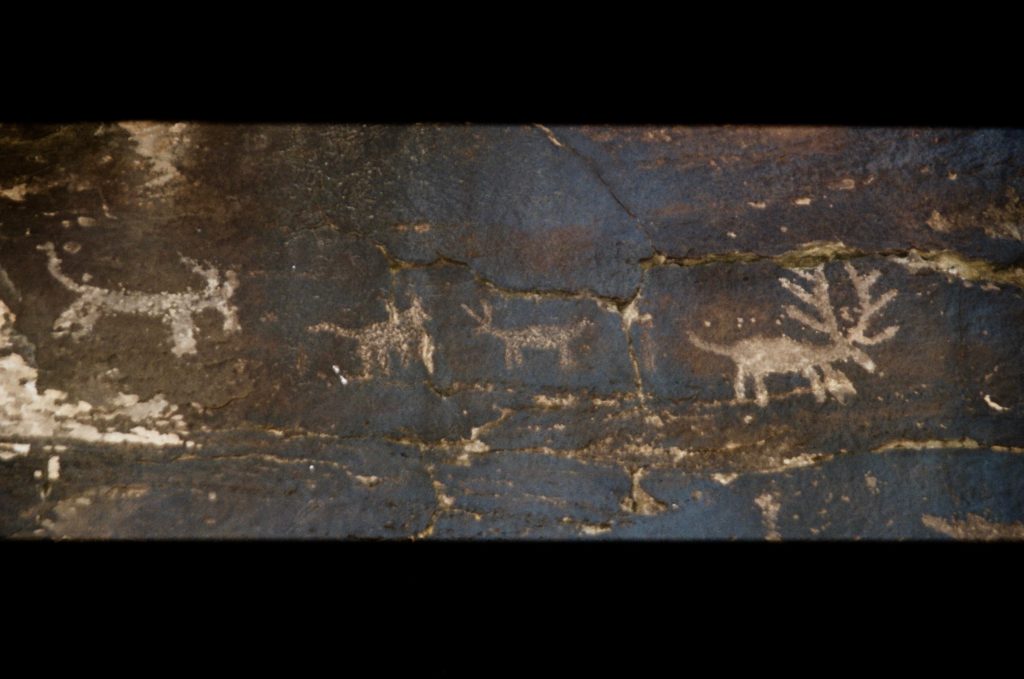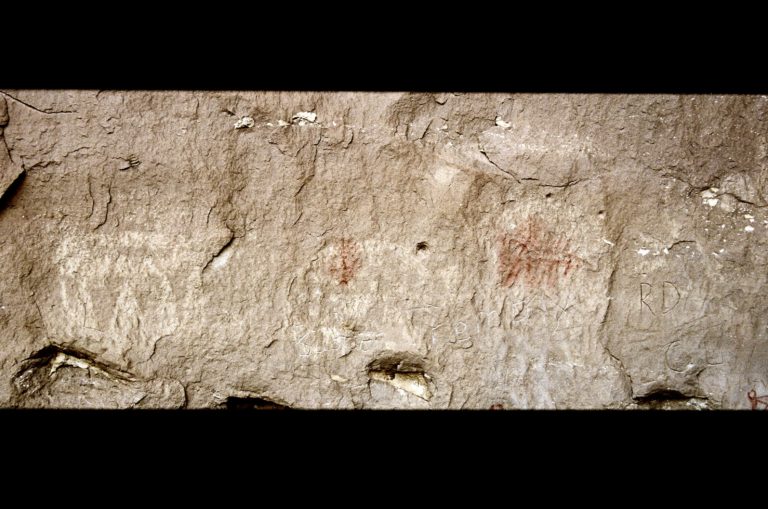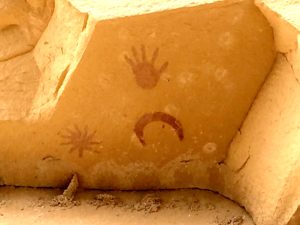
If you’ve ever had the opportunity to view a panel of ancient rock art, I am sure you had many questions run through your mind. Who made these? What do they mean? When were they created? In modern archaeology there are many methods used to date rock art, but we will discuss a few that have been used in southeast Colorado.
There are a couple of over-arching methods archaeologists use to date rock art. The scientific methods can include cation-ratio (CR) dating, and varnish micro-laminating (VML) dating. The relative dating methods can include seriation, varnish repatination and superimposition. A few of the modern researchers that have utilized these methods in southeast Colorado include; Lawrence Loendorf, Julie Francis, and Ronald Dorn during their studies of rock art on the high plains. (Zier and Kalasz, 1999)
Scientific Methods of Dating
Cation-ratio dating
(K+ + Ca2+)/Ti4+
“The premise of a new age-determination method, cation-ratio dating, is that the ratio of the more mobile cations (e.g., K and Ca) to titanium in varnish decreases with time. The method is only valid where manganese is not remobilized after deposition, for example, in most arid environments.” (Dorn, 1983)
Cation-ratio dating is used to date rock surfaces such as stone artifacts and cliff and ground drawings. It can be used to obtain dates that would be unobtainable by more conventional methods such as radiocarbon dating. Scientists use cation-ratio dating to determine how long rock surfaces have been exposed. They do this by chemically analyzing the varnish that forms on these surfaces. (science.jrank.org, 2019)
In addition to cation- ration dating in southeast, researchers have at times used accelerator mass spectrometry (AMS), a form of radio carbon dating, to gather data on the “minute carbon particles trapped beneath the varnish layer and the rock surface.” (Zier and Kalasz, 1999) To be more accurate, the cation-ratio dating is often used in conjunction with this AMS-derived data from the same rock surfaces to arrive at more absolute dates.
Varnish Micro-Laminating (VML) Dating
Studying the variations in a cross-section of “desert varnish” taken from a study site is the basis for varnish micro-laminating. “Microlaminations in rock varnish were first reported by Perry and Adams (1978), who recognized their potential as a paleoenvironmental indicator in drylands. Microlaminations can be observed when the varnish is shaved thin enough (5-10 µm) to see through in ultra-thin section with a light microscope.” (vmldating.com)
These variations can be indicators of drier and wetter periods in history allowing researchers to correlate rock art sites more accurately based on a wider base of knowledge such as regional historical climate studies. The varnish forms extremely slowly and different minerals and elements are captured at different times on the rock surface depending upon the climate at the time. At least that’s the theory. Of course, there are many debates about accuracy, but then the accuracy of nearly all modern scientific dating methods is often questioned. There are so many variables that can affect the end result. Often results are given a general timeframe of 100-200 years.
Relative Dating Methods
According to Cassells, “relative dating originated with Nicholas Steno who was one of the “fathers of geology.” In 1669 he published the Prodromus, which contained his observation that stratified sedimentary rock had its origins with horizontal layers, with the lowest levels older than the highest.” Assuming the soil formations follows the laws of superposition, it can usually be stated that the lowest cultural stratum is the oldest and the highest is the youngest. This is the simplest of the relative dating methods. (Cassells, 1983)
Before there were scientific tests such as radio carbon dating and cation-ratio dating. Determining the date of an artifact depended upon its place relative to other information around it. Such as which layer the artifact may have been found in, context of where it was found, what else was found with it etc. These are called relative dating methods. In determining the age of rock art relative dating methods include seriation, varnish repatination, and superimposition.
Seriation
Seriation is based on the assumption that artifact types have the equivalent of a life cycle. (Loendorf, 2008) In other words, rock art styles, symbols, etc. have trends. Just like hair styles – only, with probably a much longer staying power. The symbol or picture style starts, gains a high point of use, and then peters off as other styles gain use and popularity.
Seriation takes an inventory of similar rock art symbols or pictures and groups them together across many different panels. This is also called artifact sequencing. There are several types of seriation: frequency seriation, contextual seriation, evolutionary seriation, and similarity or stylistic seriation — based on different changes. (Archaeologywordsmith.com)
Seriations, in terms of rock art, are an organized look at types of rock art over time with variables such as image size, panel size, depth, varnish cover, density of rock art etc. These seriations can be used to analyze large quantities of rock art and get an idea of changing styles over time.
There is a great article on how Seriation works at this website:
Varnish Repatination

Repatination refers to the re-coloration, or the re-growth of the desert varnish after a petroglyph image has been created. Repatination occurs at various rates and degrees. A close examination of the degree of repatination can give a relative idea of how old an image may be. A great degree of repatination (darkening) indicates greater age than an image that shows only slight repatination. (NPS.gov, 2019)
Superimposition

There are times when rock art is drawn over the top of other rock art. This can help in
In the photo above, there are four very faint white shields painted high on a canyon wall, over the top of some of them are red symbols. The red symbols are thought by some to represent various forms of fertility or growth. Does this symbolize a change in the people and religion now dominant in the area? We see through history how changes the ruling people also call for changes in religion. These new beliefs were often built on the foundations of the predecessors.
Historical Collaboration
In addition to scientific and relative dating methods, there are times when a panel of rock art may seem to depict a historical or astronomical event. These can lend potential insight into the dating timeframe.

Examples could include the possible “supernova” petroglyph at Chaco Canyon below Penasco Blanco. The people at Chaco would have had the opportunity to view two known historical supernova events in 1006 AD and 1054AD. Since residents had begun building in the area in 900AD, it is possible that this petroglyph could represent one of these astronomical events.
More modern examples could include rock art panels that include depictions of horses. We know the horse was introduced in the early 1500’s by the Spanish, most likely Cortez. As a consequence, we have a firm time line by which to then date these specific petroglyphs. We can possibly gain a more concise understanding of other petroglyphs on a related panel when used in conjunction with other scientific methods of dating. Depending on style of construction, superimposition, re-patination etc. we gain a better understanding of other petroglyphs that may be nearby.
Conclusion
There are many methods of attempting to date rock art. The ones included here are only a few. Scientific methods are continually being developed to gain more accurate data. However, on the whole no method is considered as acurate as using multiple methods to collaborate data. Scientific methods are used in conjunction with relative dating methods to gain a more acurate understanding of a site, panel or picture.
References
Archaeology Wordsmith, Seriation, https://archaeologywordsmith.com/search.php?q=seriation, 2019
Cassells, Steve E., The Archaeology of Colorado, Chapter 4-Dating (pg 27-35), 1983
Christian J. Zier and Stephen M. Kalasz, Colorado Prehistory; A Context for the Arkansas River Basin, Pg 52-55, 1999
K. Kris Hirst, An Introduction to Seriation; Scientific Dating Before Radiocarbon, https://www.thoughtco.com/seriation-scientific-dating-before-radiocarbon-170607, 2018
Lawrence L. Loendorf, Thunder and Herds; Rock Art of the High Plains, Pg. 33-43, 2008
National Park Service; Petroglyph National Monument, Definitions; Repatination, https://www.nps.gov/petr/planyourvisit/def.htm), 2012
Net Industries, Dating Techniques; Cation- Ratio Dating, https://science.jrank.org/pages/1951/Dating-Techniques-Cation-ratio-dating.html, 2019
Science Direct, Bruce A. Buchholz, … Kirsty L. Spalding, in New Perspectives in Forensic Human Skeletal Identification, https://www.sciencedirect.com/topics/medicine-and-dentistry/accelerator-mass-spectrometry, 2018
VML Dating Lab, VML Dating: An Introduction, http://www.vmldating.com
